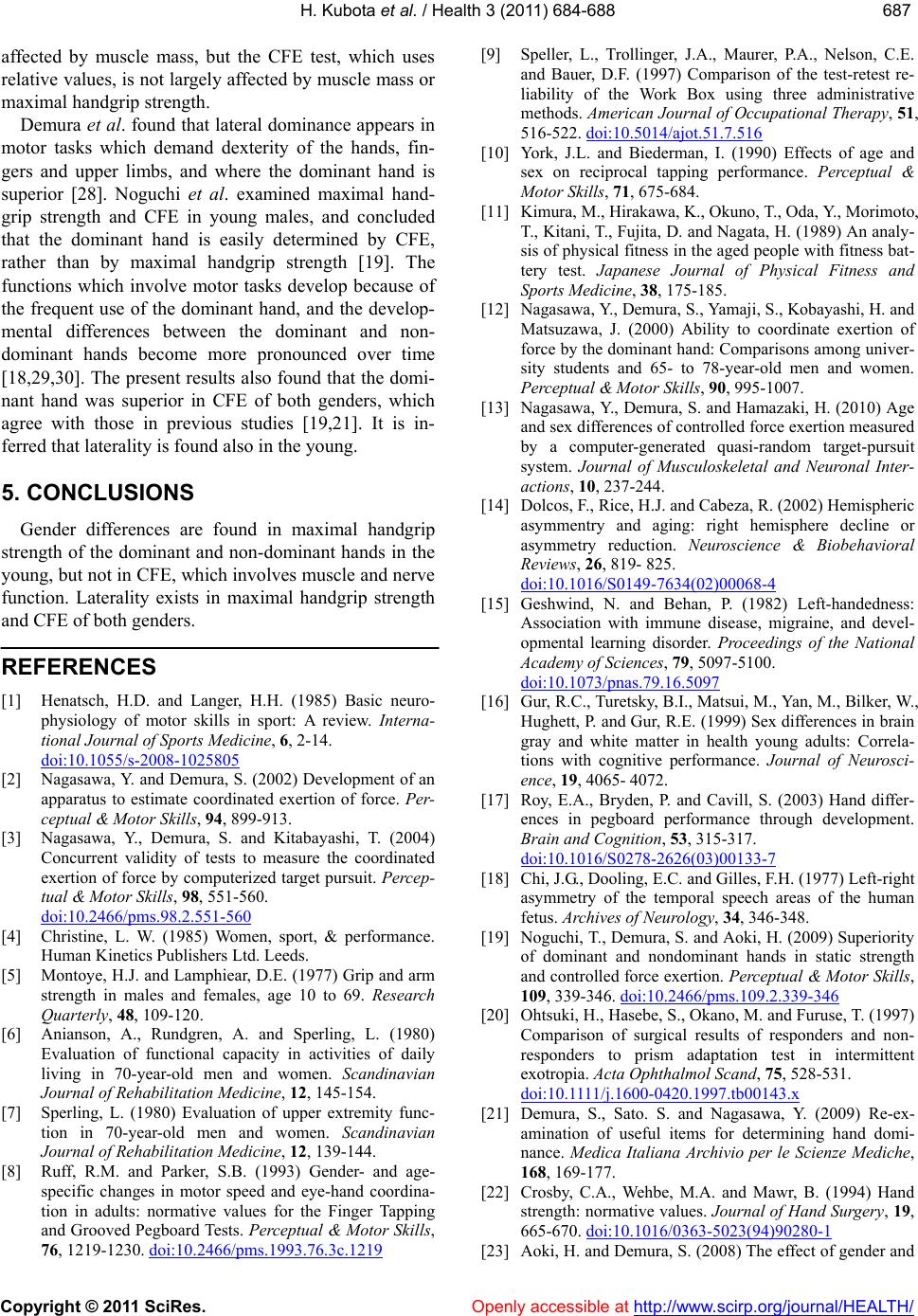
H. Kubota et al. / Health 3 (2011) 684-688
Copyright © 2011 SciRes. Openly accessible at http://www.scirp.org/journal/HEALTH/
687687
affected by muscle mass, but the CFE test, which uses
relative values, is not largely affected by muscle mass or
maximal handgrip strength.
Demura et al. found that lateral dominance appears in
motor tasks which demand dexterity of the hands, fin-
gers and upper limbs, and where the dominant hand is
superior [28]. Noguchi et al. examined maximal hand-
grip strength and CFE in young males, and concluded
that the dominant hand is easily determined by CFE,
rather than by maximal handgrip strength [19]. The
functions which involve motor tasks develop because of
the frequent use of the dominant hand, and the develop-
mental differences between the dominant and non-
dominant hands become more pronounced over time
[18,29,30]. The present results also found that the domi-
nant hand was superior in CFE of both genders, which
agree with those in previous studies [19,21]. It is in-
ferred that laterality is found also in the young.
5. CONCLUSIONS
Gender differences are found in maximal handgrip
strength of the dominant and non-dominant hands in the
young, but not in CFE, which involves muscle and nerve
function. Laterality exists in maximal handgrip strength
and CFE of both genders.
REFERENCES
[1] Henatsch, H.D. and Langer, H.H. (1985) Basic neuro-
physiology of motor skills in sport: A review. Interna-
tional Journal of Sports Medicine, 6, 2-14.
doi:10.1055/s-2008-1025805
[2] Nagasawa, Y. and Demura, S. (2002) Development of an
apparatus to estimate coordinated exertion of force. Per-
ceptual & Motor Skills, 94, 899-913.
[3] Nagasawa, Y., Demura, S. and Kitabayashi, T. (2004)
Concurrent validity of tests to measure the coordinated
exertion of force by computerized target pursuit. Percep-
tual & Motor Skills, 98, 551-560.
doi:10.2466/pms.98.2.551-560
[4] Christine, L. W. (1985) Women, sport, & performance.
Human Kinetics Publishers Ltd. Leeds.
[5] Montoye, H.J. and Lamphiear, D.E. (1977) Grip and arm
strength in males and females, age 10 to 69. Research
Quarterly, 48, 109-120.
[6] Anianson, A., Rundgren, A. and Sperling, L. (1980)
Evaluation of functional capacity in activities of daily
living in 70-year-old men and women. Scandinavian
Journal of Rehabilitation Medicine, 12, 145-154.
[7] Sperling, L. (1980) Evaluation of upper extremity func-
tion in 70-year-old men and women. Scandinavian
Journal of Rehabilitation Medicine, 12, 139-144.
[8] Ruff, R.M. and Parker, S.B. (1993) Gender- and age-
specific changes in motor speed and eye-hand coordina-
tion in adults: normative values for the Finger Tapping
and Grooved Pegboard Tests. Perceptual & Motor Skills,
76, 1219-1230. doi:10.2466/pms.1993.76.3c.1219
[9] Speller, L., Trollinger, J.A., Maurer, P.A., Nelson, C.E.
and Bauer, D.F. (1997) Comparison of the test-retest re-
liability of the Work Box using three administrative
methods. American Journal of Occupational Therapy, 51,
516-522. doi:10.5014/ajot.51.7.516
[10] York, J.L. and Biederman, I. (1990) Effects of age and
sex on reciprocal tapping performance. Perceptual &
Motor Skills, 71, 675-684.
[11] Kimura, M., Hirakawa, K., Okuno, T., Oda, Y., Morimoto,
T., Kitani, T., Fujita, D. and Nagata, H. (1989) An analy-
sis of physical fitness in the aged people with fitness bat-
tery test. Japanese Journal of Physical Fitness and
Sports Medicine, 38, 175-185.
[12] Nagasawa, Y., Demura, S., Yamaji, S., Kobayashi, H. and
Matsuzawa, J. (2000) Ability to coordinate exertion of
force by the dominant hand: Comparisons among univer-
sity students and 65- to 78-year-old men and women.
Perceptual & Motor Skills, 90, 995-1007.
[13] Nagasawa, Y., Demura, S. and Hamazaki, H. (2010) Age
and sex differences of controlled force exertion measured
by a computer-generated quasi-random target-pursuit
system. Journal of Musculoskeletal and Neuronal Inter-
actions, 10, 237-244.
[14] Dolcos, F., Rice, H.J. and Cabeza, R. (2002) Hemispheric
asymmentry and aging: right hemisphere decline or
asymmetry reduction. Neuroscience & Biobehavioral
Reviews, 26, 819- 825.
doi:10.1016/S0149-7634(02)00068-4
[15] Geshwind, N. and Behan, P. (1982) Left-handedness:
Association with immune disease, migraine, and devel-
opmental learning disorder. Proceedings of the National
Academy of Sciences, 79, 5097-5100.
doi:10.1073/pnas.79.16.5097
[16] Gur, R.C., Turetsky, B.I., Matsui, M., Yan, M., Bilker, W.,
Hughett, P. and Gur, R.E. (1999) Sex differences in brain
gray and white matter in health young adults: Correla-
tions with cognitive performance. Journal of Neurosci-
ence, 19, 4065- 4072.
[17] Roy, E.A., Bryden, P. and Cavill, S. (2003) Hand differ-
ences in pegboard performance through development.
Brain and Cognition, 53, 315-317.
doi:10.1016/S0278-2626(03)00133-7
[18] Chi, J.G., Dooling, E.C. and Gilles, F.H. (1977) Left-right
asymmetry of the temporal speech areas of the human
fetus. Archives of Neurology, 34, 346-348.
[19] Noguchi, T., Demura, S. and Aoki, H. (2009) Superiority
of dominant and nondominant hands in static strength
and controlled force exertion. Perceptual & Motor Skills,
109, 339-346. doi:10.2466/pms.109.2.339-346
[20] Ohtsuki, H., Hasebe, S., Okano, M. and Furuse, T. (1997)
Comparison of surgical results of responders and non-
responders to prism adaptation test in intermittent
exotropia. Acta Ophthalmol Sca nd, 75, 528-531.
doi:10.1111/j.1600-0420.1997.tb00143.x
[21] Demura, S., Sato. S. and Nagasawa, Y. (2009) Re-ex-
amination of useful items for determining hand domi-
nance. Medica Italiana Archivio per le Scienze Mediche,
168, 169-177.
[22] Crosby, C.A., Wehbe, M.A. and Mawr, B. (1994) Hand
strength: normative values. Journal of Hand Surgery , 19,
665-670. doi:10.1016/0363-5023(94)90280-1
[23] Aoki, H. and Demura, S. (2008) The effect of gender and